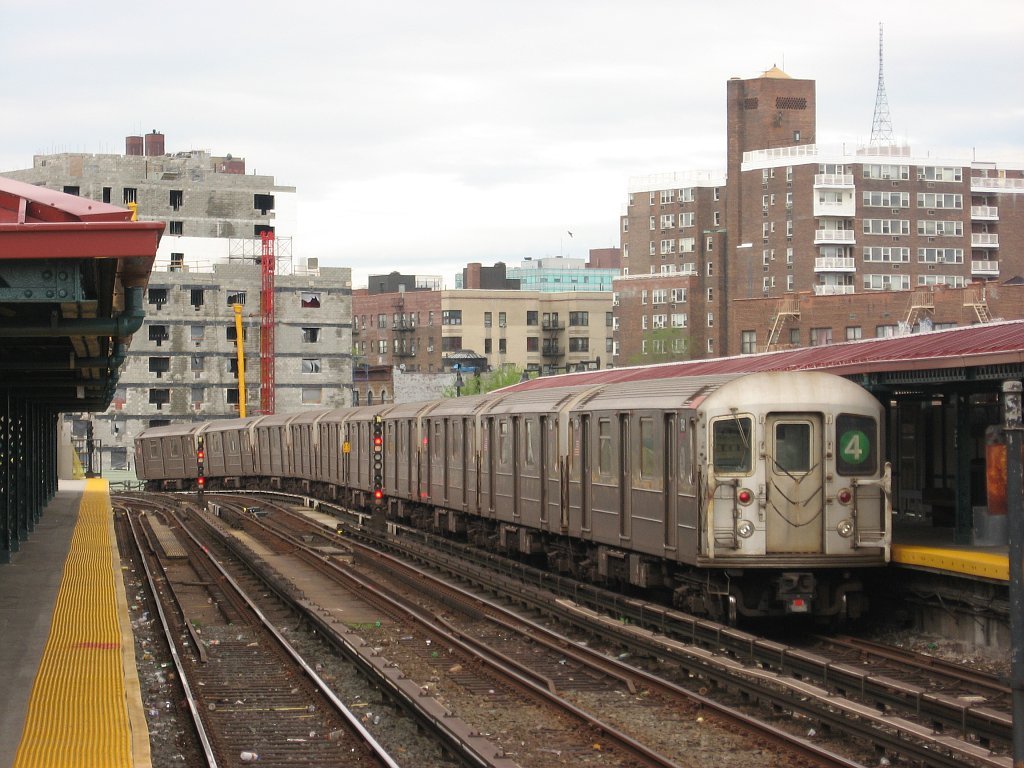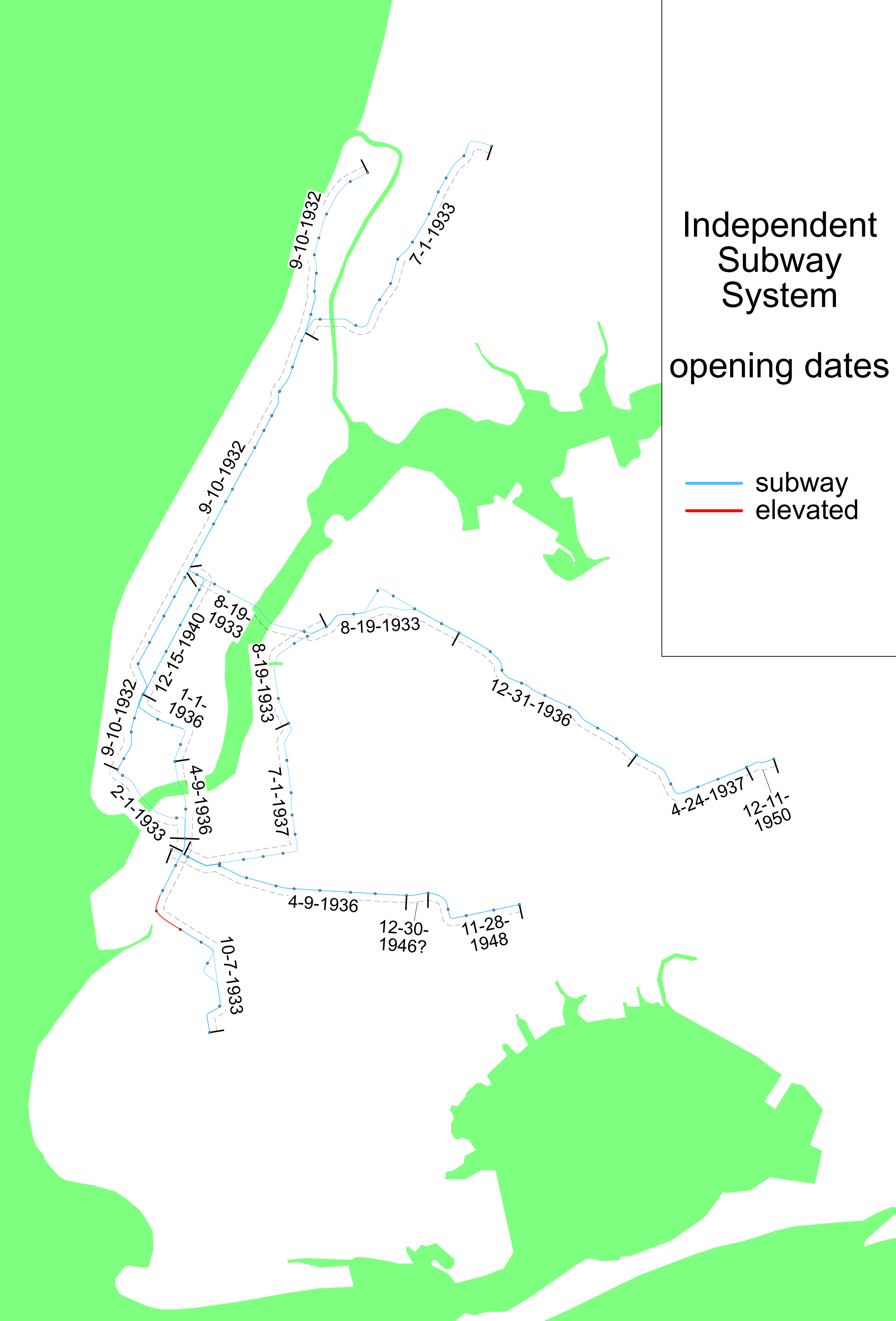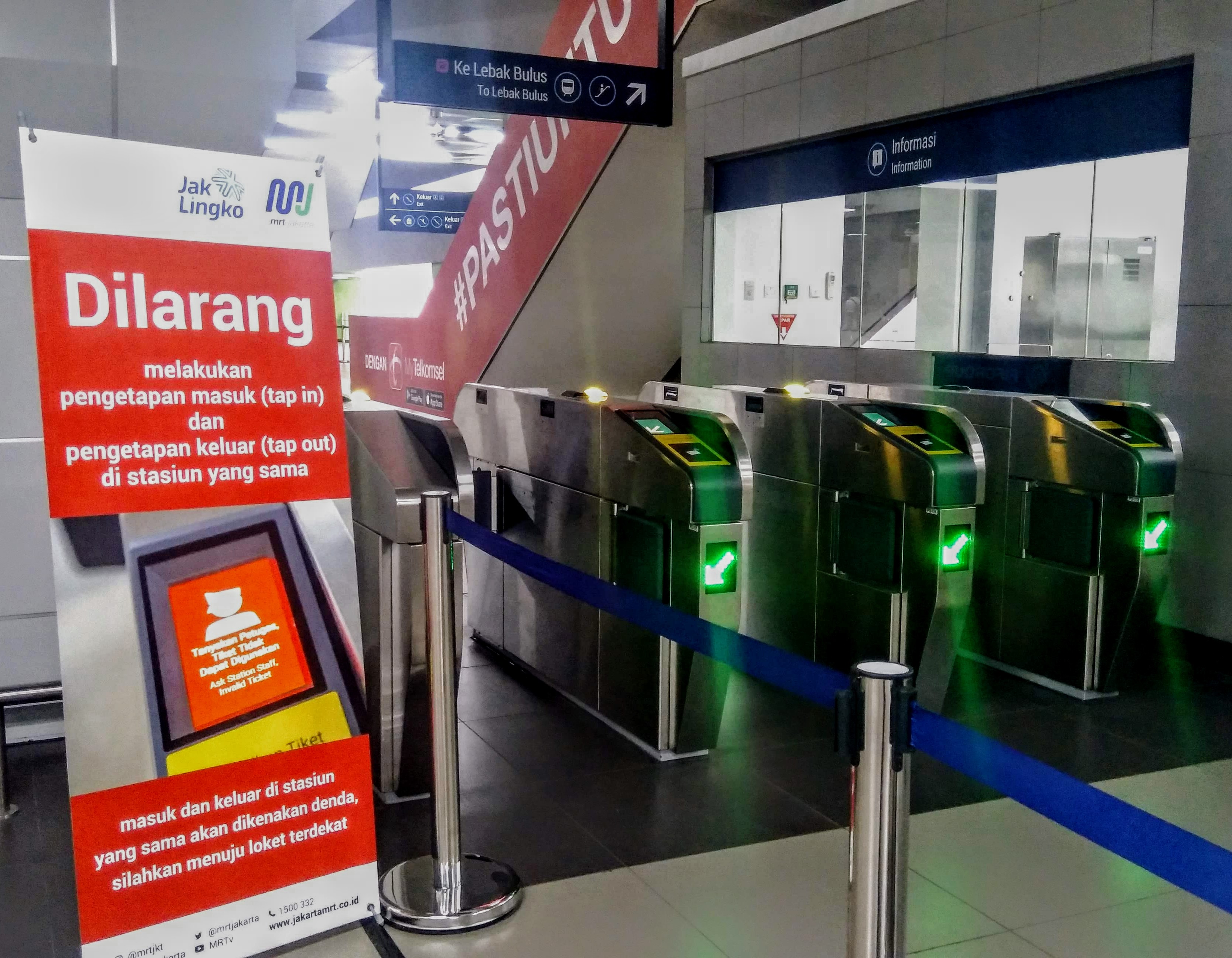|
Bedford Park Boulevard–Lehman College Station
The Bedford Park Boulevard–Lehman College station (formerly Bedford Park Boulevard–200th Street station) is a local station on the IRT Jerome Avenue Line of the New York City Subway. Located at the intersection of Bedford Park Boulevard (formerly 200th Street) immediately west of Jerome Avenue in the Bronx, it is served by the 4 train at all times. It is also the only station on the Jerome Avenue Line north of 170th Street that is not located above Jerome Avenue. This station was constructed by the Interborough Rapid Transit Company as part of the Dual Contracts and opened in 1918. History Construction and opening The Dual Contracts, which were signed on March 19, 1913, were contracts for the construction and/or rehabilitation and operation of rapid transit lines in the City of New York. The contracts were "dual" in that they were signed between the City and two separate private companies (the Interborough Rapid Transit Company and the Brooklyn Rapid Transit Company), ... [...More Info...] [...Related Items...] OR: [Wikipedia] [Google] [Baidu] |
Government Of New York City
The government of New York City, headquartered at New York City Hall in Lower Manhattan, is organized under the New York City Charter and provides for a mayor-council system. The mayor is elected to a four-year term and is responsible for the administration of city government. The New York City Council is a unicameral body consisting of 51 members, each elected from a geographic district, normally for four-year terms. All elected officials are subject to a two consecutive-term limit. The court system consists of two citywide courts and three statewide courts. New York City government employs approximately 330,000 people, more than any other city in the United States and more than any U.S. state but three: California, Texas, and New York. The city government is responsible for public education, correctional institutions, public safety, recreational facilities, sanitation, water supply, and welfare services. New York City consists of five boroughs, each coextensive with one ... [...More Info...] [...Related Items...] OR: [Wikipedia] [Google] [Baidu] |
Brooklyn Rapid Transit Company
The Brooklyn Rapid Transit Company (BRT) was a public transit holding company formed in 1896 to acquire and consolidate railway lines in Brooklyn and Queens, New York City, United States. It was a prominent corporation and industry leader using the single-letter symbol B on the New York Stock Exchange. It operated both passenger and freight services on its rail rapid transit, elevated and subway network, making it unique among the three companies which built and operated subway lines in New York City. It became insolvent in 1919 and was restructured and released from bankruptcy as the Brooklyn–Manhattan Transit Corporation in 1923. Consolidation The BRT was incorporated January 18, 1896, and took over the bankrupt Long Island Traction Company in early February acquiring the Brooklyn Heights Railroad and the lessee of the Brooklyn City Rail Road. It then acquired the Brooklyn, Queens County and Suburban Railroad leased on July 1, 1898. The BRT took over the property of a numbe ... [...More Info...] [...Related Items...] OR: [Wikipedia] [Google] [Baidu] |
Botanical Garden (Metro-North Station)
Botanical Garden station (also known as Botanical Garden–East 200th Street station) is a commuter rail stop on the Metro-North Railroad's Harlem Line, serving the Bedford Park section of the Bronx, New York City. It is from Grand Central Terminal and travel time there is approximately 22 minutes. The station is located just north of the intersection of Southern Boulevard and Bedford Park Boulevard (East 200th Street) adjacent to northern Bronx Park and the New York Botanical Garden. The station is located in the Zone 2 Metro-North fare zone. History Prior to the establishment of the Botanical Garden station, its location was the former site of Bedford Park station, a railroad station that connected to a privately owned one-mile spur leading west to the Jerome Park Racetrack, which contained its own station of the same name. The racetrack was closed on October 4, 1894 to make way for the installation of the Jerome Park Reservoir, and the spur was used for construction of the ... [...More Info...] [...Related Items...] OR: [Wikipedia] [Google] [Baidu] |
Metro-North Railroad
Metro-North Railroad , trading as MTA Metro-North Railroad, is a suburban commuter rail service run by the Metropolitan Transportation Authority (MTA), a New York State public benefit corporations, public authority of the U.S. state of New York (state), New York and under contract with the Connecticut Department of Transportation. Metro-North runs service between New York City and its northern suburbs in New York and Connecticut, including Port Jervis, New York, Port Jervis, Spring Valley, New York, Spring Valley, Poughkeepsie, New York, Poughkeepsie, Yonkers, New York, Yonkers, New Rochelle, New York, New Rochelle, Mount Vernon, New York, Mount Vernon, White Plains, New York, White Plains, Southeast station, Southeast and Wassaic, New York, Wassaic in New York and Stamford, Connecticut, Stamford, New Canaan, Connecticut, New Canaan, Danbury, Connecticut, Danbury, Bridgeport, Connecticut, Bridgeport, Waterbury, Connecticut, Waterbury, and New Haven, Connecticut, New Haven in Con ... [...More Info...] [...Related Items...] OR: [Wikipedia] [Google] [Baidu] |
New York Botanical Garden
The New York Botanical Garden (NYBG) is a botanical garden at Bronx Park in the Bronx, New York City. Established in 1891, it is located on a site that contains a landscape with over one million living plants; the Enid A. Haupt Conservatory, a greenhouse containing several habitats; and the LuEsther T. Mertz Library, which contains one of the world's largest collections of botany-related texts. , over a million people visit the New York Botanical Garden annually. NYBG is also a major educational institution, teaching visitors about plant science, ecology, and healthful eating through NYBG's interactive programming. Nearly 90,000 of the annual visitors are children from underserved neighboring communities. An additional 3,000 are teachers from New York City's public school system participating in professional development programs that train them to teach science courses at all grade levels. NYBG operates one of the world's largest plant research and conservation programs. NY ... [...More Info...] [...Related Items...] OR: [Wikipedia] [Google] [Baidu] |
Mezzanine (architecture)
A mezzanine (; or in Italian, a ''mezzanino'') is an intermediate floor in a building which is partly open to the double-height ceilinged floor below, or which does not extend over the whole floorspace of the building, a loft with non-sloped walls. However, the term is often used loosely for the floor above the ground floor, especially where a very high-ceilinged original ground floor has been split horizontally into two floors. Mezzanines may serve a wide variety of functions. Industrial mezzanines, such as those used in warehouses, may be temporary or semi-permanent structures. In Royal Italian architecture, ''mezzanino'' also means a chamber created by partitioning that does not go up all the way to the arch vaulting or ceiling; these were historically common in Italy and France, for example in the palaces for the nobility at the Quirinal Palace. Definition A mezzanine is an intermediate floor (or floors) in a building which is open to the floor below. It is placed halfwa ... [...More Info...] [...Related Items...] OR: [Wikipedia] [Google] [Baidu] |
Independent Subway System
The Independent Subway System (IND or ISS), formerly known as the Independent City-Owned Subway System (ICOSS) or the Independent City-Owned Rapid Transit Railroad (ICORTR), was a rapid transit rail system in New York City that is now part of the New York City Subway. It was first constructed as the Eighth Avenue Line in Manhattan in 1932. One of three rail networks that became part of the modern New York City subway, the IND was intended to be fully owned and operated by the municipal government, in contrast to the privately operated or jointly funded Interborough Rapid Transit Company (IRT) and Brooklyn–Manhattan Transit Corporation (BMT) companies. It was merged with these two networks in 1940. The original IND service lines are the modern subway's A, B, C, D, E, F, and G services. In addition, the BMT's M, N, Q and R now run partly on IND trackage. The Rockaway Park Shuttle supplements the A service. For operational purposes, the IND and BMT lines and service ... [...More Info...] [...Related Items...] OR: [Wikipedia] [Google] [Baidu] |
Bedford Park Boulevard Station Entrance
Bedford is a market town in Bedfordshire, England. At the 2011 Census, the population of the Bedford built-up area (including Biddenham and Kempston) was 106,940, making it the second-largest settlement in Bedfordshire, behind Luton, whilst the Borough of Bedford had a population of 157,479. Bedford is also the historic county town of Bedfordshire. Bedford was founded at a ford on the River Great Ouse and is thought to have been the burial place of King Offa of Mercia, who is remembered for building Offa's Dyke on the Welsh border. Bedford Castle was built by Henry I, although it was destroyed in 1224. Bedford was granted borough status in 1165 and has been represented in Parliament since 1265. It is known for its large population of Italian descent. History The name of the town is believed to derive from the name of a Saxon chief called Beda, and a ford crossing the River Great Ouse. Bedford was a market town for the surrounding agricultural region from the early Middl ... [...More Info...] [...Related Items...] OR: [Wikipedia] [Google] [Baidu] |
Railroad Switch
A railroad switch (), turnout, or ''set ofpoints () is a mechanical installation enabling railway trains to be guided from one track to another, such as at a railway junction or where a spur or siding branches off. The most common type of switch consists of a pair of linked tapering rails, known as ''points'' (''switch rails'' or ''point blades''), lying between the diverging outer rails (the ''stock rails''). These points can be moved laterally into one of two positions to direct a train coming from the point blades toward the straight path or the diverging path. A train moving from the narrow end toward the point blades (i.e. it will be directed to one of the two paths, depending on the position of the points) is said to be executing a ''facing-point movement''. For many types of switch, a train coming from either of the converging directions will pass through the switch regardless of the position of the points, as the vehicle's wheels will force the points to move. ... [...More Info...] [...Related Items...] OR: [Wikipedia] [Google] [Baidu] |
Fare Control
In rail transport, the paid area is a dedicated "inner" zone in a railway station or metro station, accessible via turnstiles or other barriers, to get into which, visitors or passengers require a valid ticket, checked smartcard or a pass. A system using paid areas is often called fare control. Passengers are allowed to enter or exit only through a faregate. A paid area usually exists in rapid transit railway stations for separating the train platform from the station exit, ensuring a passenger has paid or prepaid before reaching the railway platform and using any transport service. Such design requires a well-organized railway station layout. In some systems, paid areas are named differently - for example, on railways in the United Kingdom they are called compulsory ticket areas The paid area is similar in concept to the airside at an airport. However, in most cases entrance to the paid area requires only a valid ticket or transit pass. The exception is in certain cases of inter ... [...More Info...] [...Related Items...] OR: [Wikipedia] [Google] [Baidu] |
Woodlawn (IRT Jerome Avenue Line)
The Woodlawn station (sometimes called Woodlawn–Jerome Avenue station) is the northern terminal of the New York City Subway's IRT Jerome Avenue Line. The station is located at the intersection of Bainbridge and Jerome Avenues, outside Woodlawn Cemetery. Despite the station name, this intersection is in the Norwood section of the Bronx, and not in Woodlawn. It is served by the 4 train at all times. This station was constructed by the Interborough Rapid Transit Company as part of the Dual Contracts and opened in 1918. Its opening helped spur development of the area that had begun with the opening of nearby Woodlawn Cemetery. Following renovations in 2005, it was listed on the National Register of Historic Places for its use of ornamental concrete. A public art display of stained glass called ''Children at Play'' was also installed. History Background In the 1840s, the Harlem Railroad made the first rail connection between Manhattan and what became the Woodlawn neighborh ... [...More Info...] [...Related Items...] OR: [Wikipedia] [Google] [Baidu] |
Kingsbridge Road (IRT Jerome Avenue Line)
The Kingsbridge Road station is a local station on the elevated IRT Jerome Avenue Line of the New York City Subway. Located at the intersection of Kingsbridge Road and Jerome Avenue in Kingsbridge Heights, Bronx, it is served by the 4 train at all times. This station was constructed by the Interborough Rapid Transit Company as part of the Dual Contracts and opened in 1917. History Construction and opening The Dual Contracts, which were signed on March 19, 1913, were contracts for the construction and/or rehabilitation and operation of rapid transit lines in the City of New York. The contracts were "dual" in that they were signed between the City and two separate private companies (the Interborough Rapid Transit Company and the Brooklyn Rapid Transit Company), all working together to make the construction of the Dual Contracts possible. The Dual Contracts promised the construction of several lines in the Bronx. As part of Contract 3, the IRT agreed to build an elevated line a ... [...More Info...] [...Related Items...] OR: [Wikipedia] [Google] [Baidu] |







